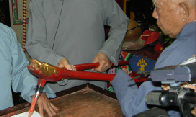4-1 宣講聖諭
宣講聖諭
「宣講」類似現在的公開演講,傳統社會識字者是少數精英,由知識份子透過口語傳達政令。
清代,規定地方官在每月初一和十五宣講聖諭。日治後,仕紳將宣講與鸞堂結合,以《聖諭廣訓》為底本,著重因果報應的教理故事,教化民俗。
鸞堂宣講
鸞堂以善書宣講進行社會教化,以期芸芸眾生「諸惡莫作,眾善奉行」。鸞堂定期扶鸞,將聖賢仙佛勸善訓文向信徒宣講,並匯集成冊,就是鸞書。
宣講的時間與地點
宣講沒有固定的地點,只要適當與方便,都可以考慮,但以三種地點最常用:寺廟、官署、書生和鄉耆聚會的公所。
宣講活動的文化意義
宣講活動的內容:1.聖諭十六條、2.政令宣導、3.善書宣講。
早期宣講,講述二十四孝、因果故事、教忠教孝等故事例證;如今宣講活動,是一種道德教育,公民教育、政令宣導、宣揚勸善教化。
"Preaching" is public speaking. In traditional society, literate people were an elite minority. Government decrees were passed along orally by intellectuals.
Preaching in Phoenix Halls
Phoenix Halls regularly host spirit writing to spread the words of sages and Buddhas to encourage virtue among followers. These lessons are collated into phoenix books.
The time and Place for Preaching
Preaching does not have to be done in a certain location.
Anywhere suitable and convenient can be considered, but preaching is done primarily in three types of locales: |









